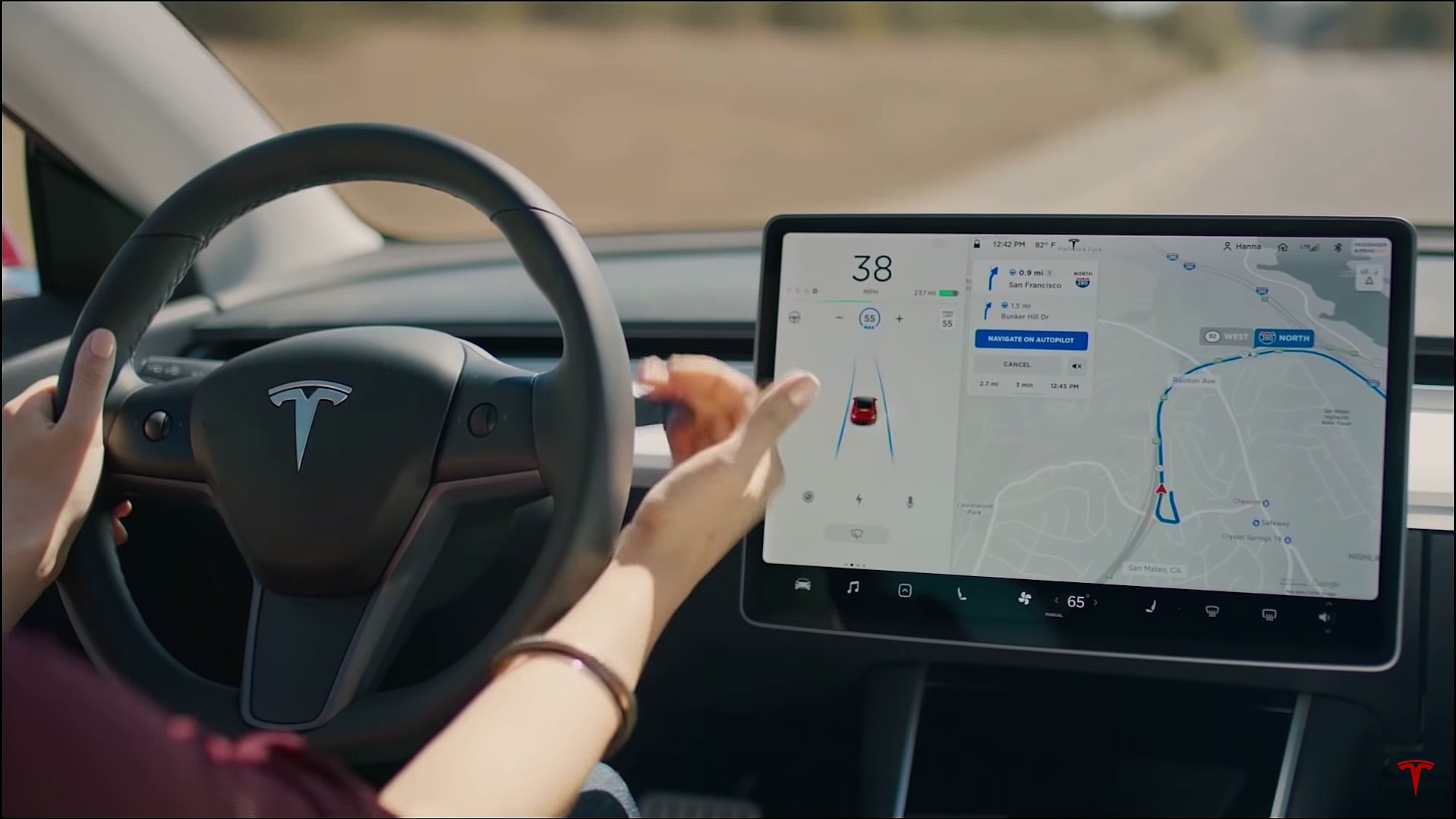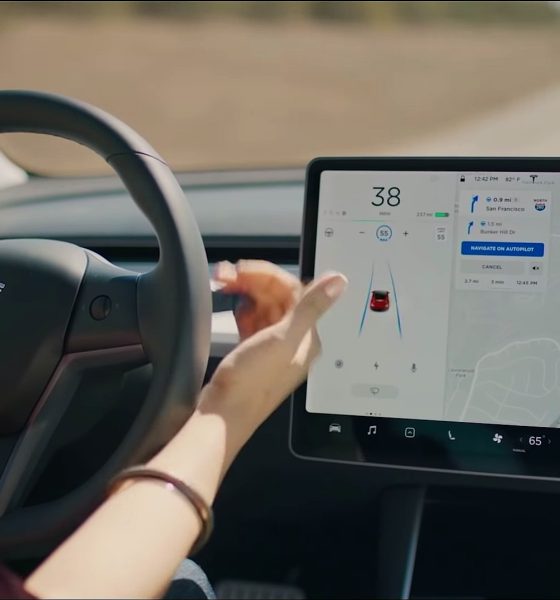Tesla Autopilot continues to be taboo to many people, and it is understandable. In a world where people have absolute control over everything in their life, it is tough to assume many people would be comfortable with their car driving itself. But the issue is, many people, countries, and entities are not willing to give the self-driving characteristic a chance.
Despite Autopilot’s impressive performance figures, Germany announced this week that Tesla could not use the word “Autopilot” in any advertising, because it still requires the driver to remain attentive during its use. But the problem is, Autopilot, in any sense of the word, doesn’t state the vehicle in question can operate entirely on its own. Tesla’s description of the function also requires the driver to keep their hands on the wheel at all times in case of an emergency.
But the issue really comes down to the taboo subject of self-driving vehicles. To my surprise, many people outside the Tesla community are still uninformed and misguided on Autopilot’s capabilities. Every time one of my friends or family members see a Tesla, they automatically think it’s driving itself, and the operator is sitting in the passenger seat playing on their phone.
We all know that Autopilot doesn’t work that way. And even though Tesla is head and shoulders above the competition in terms of self-driving capabilities, they still can’t drive themselves, but the company has never indicated that their vehicles are fully autonomous.
The Tesla community knows that.
However, there are groups of people and even entire countries that still seem to believe that Tesla’s Autopilot claims are unrealistic and “misleading.” In reality, the company’s cars do exactly what the electric automaker claims they do.
This is not the first time a country has thrown Autopilot away because Israel altogether outlawed any use of the capability in the past. However, after revisiting the case, Israel government officials got a more concrete understanding of how Autopilot works, and they allowed the use of the feature by vehicles that were capable of using it.
A big thanks to our long-time supporters and new subscribers! Thank you.
In my opinion, everyone who is skeptical of Autopilot, especially those who are government officials, should be required to undergo a crash course of the feature and take a ride in a Tesla vehicle while it is using the characteristic.
However, there is something even more surprising to me personally about all of the taboo there is surrounding Autopilot. More of it is from Tesla skeptics and TSLAQ, but you rarely hear about Autopilot navigating through tricky road layouts on mainstream media outlets. It is more about Tesla vehicles that were using Autopilot, ending up in accidents.
Teslarati has covered a series of examples of Autopilot navigating plenty of interesting terrains and situations with relative ease. We cover accidents, too, but we clarify how they occurred. For example, this past week, a Model S collided with a State Trooper and an Ambulance. However, the driver was under suspicion for DUI, although it has not yet been confirmed.
Autopilot is a way for drivers to take the stress out of driving. I know, personally, that I don’t like driving very much. I was in two car accidents in high school, I was not the driver in either instance. Along with seeing accidents on I-95 near Baltimore and other winding backroads near my house, drivers scare me, and I rarely trust anyone operating a car that I’m in.
I would feel safer if Autopilot was operating every car on the road. Not only would the cars get better every single day because of Tesla’s Neural Net, but people wouldn’t be so unpredictable with their driving behavior, and I genuinely believe we all would be much better off.
In the past, technological advancements have been second-guessed. At one time, NASA launched a spaceship to the Moon, and it used less technology than an iPhone. Things advance and opinions change on something. People are going to eventually warm up to the idea of a car driving itself, and there is a chance that even the most vocal skeptics of the self-driving car movement will ultimately utilize the capability to get them from Point A to Point B.
Please consider Subscribing and joining me next week as I go ‘Beyond the News’

Elon Musk
Elon Musk’s Biggest Revelations on AI, Robots, and the Future of Work from the Moonshots Podcast

Elon Musk’s appearance on the Moonshots with Peter Diamandis podcast was packed with bold predictions, candid admissions, and surprising tech insights. The nearly three-hour conversation covered everything from artificial intelligence to humanoid robots, geopolitics, and the future of work. Here are the top 10 most intriguing takeaways:
-
Aggressive AGI Timeline Predictions
Musk offered a detailed view on when artificial general intelligence (AGI) could emerge, suggesting it may arrive sooner than many expect, emphasizing both transformative potential and risks.
-
U.S. vs. China in the AI Race
He discussed the strategic competition between the United States and China over AI development, noting that geopolitical dynamics will shape how and who leads in the next decades.
-
Future of Job Markets
Musk touched on how AI and automation could reshape employment, predicting massive boosts in productivity alongside potential disruptions in traditional work structures.
-
Clean Energy Transition
A recurring theme was the role of clean energy in future economies, with Musk reiterating the importance of scaling sustainable power generation and storage.
-
Humanoid Robots Are Coming
On the podcast, Musk elaborated on Tesla’s work on humanoid robots, hinting at timelines and applications that go beyond factories to general-purpose assistance.
-
Tesla Roadster “Last Human-Driven Car”
Outside the core discussion topics, Musk teased features of the upcoming Tesla Roadster — calling it “the best of the last of the human-driven cars” and suggesting safety won’t be its main selling point.
-
The Role of AI in Clean Energy and Robotics
Linking AI to both energy optimization and robotics, Musk explained how smarter systems could accelerate decarbonization and task automation across industries.
-
U.S. Innovation Leadership
Musk argued that maintaining American leadership in key tech sectors like AI, space, and robotics should be a national priority, with thoughtful policy and investment.
-
Job Creation vs. Job Elimination
While acknowledging automation’s disruptive effects, he also outlined scenarios where new industries and opportunities could emerge, particularly in AI, space, and advanced manufacturing.
-
Long-Term Vision for Humanity
Throughout the conversation, Musk revisited his long-term philosophical views — including a belief in humanity’s responsibility to become a multi-planetary and technologically empowered species.
Whether you agree with Musk’s optimism or not, the podcast offers a window into the thinking of one of the most influential figures in tech today, in and why his visions continue to spark debate and inspiration.
Elon Musk
Elon Musk just said some crazy stuff about the Tesla Roadster

Elon Musk appeared on the Moonshots podcast with Peter Diamandis today to discuss AGI, U.S. vs. China, Tesla, and some other interesting topics, but there was some discussion about the upcoming unveiling of the Roadster, the company’s electric supercar that will arrive several years after it was initially slated for release.
Musk made some pretty amazing claims about the Roadster; we already know it is supposed to be lightning-fast and could even hover, if Tesla gets everything to happen the way it wants to. However, the car has some pretty crazy capabilities, some of which have not even been revealed.
On the podcast, Musk said:
“This is not a…safety is not the main goal. If you buy a Ferrari, safety is not the number one goal. I say, if safety is your number one goal, do not buy the Roadster…We’ll aspire not to kill anyone in this car. It’ll be the best of the last of the human-driven cars. The best of the last.”
🚨 Elon on the Roadster unveiling, scheduled for April 1:
— TESLARATI (@Teslarati) January 6, 2026
Musk makes a good point: people who buy expensive sports cars with ridiculous top speeds and acceleration rates do not buy them to be safe. They hope they are safe in case of an emergency or crash, but safety is not at the forefront of their thoughts, because nobody buys a car thinking they’ll crash it.
The Roadster is truly going to push the limits and capabilities of passenger vehicles; there’s no doubt about that. Tesla plans to show off the new version car for the first time on April 1, and Musk has only hinted at what is possible with it.
Musk said back in November:
“Whether it’s good or bad, it will be unforgettable. My friend Peter Thiel once reflected that the future was supposed to have flying cars, but we don’t have flying cars. I think if Peter wants a flying car, he should be able to buy one…I think it has a shot at being the most memorable product unveiling ever. [It will be unveiled] hopefully before the end of the year. You know, we need to make sure that it works. This is some crazy technology in this car. Let’s just put it this way: if you took all the James Bond cars and combined them, it’s crazier than that.”
Production is set to begin between 12 and 18 months after the unveiling, which would put the car out sometime in 2027. Hopefully, Tesla is able to stay on track with the scheduling of the Roadster; many people have been waiting a long time for it.
News
Tesla launches hiring for Robotaxi program in its twentieth country
Overall, the hiring signals Tesla’s aggressive timeline for global dominance in autonomous mobility.

Tesla has launched a hiring initiative for its Robotaxi program in its twentieth country, as the company posted two new jobs in Thailand this week.
Tesla is hiring in Bangkok and Kowloon for the Vehicle Operator position, which is related to data collection, and is the first in Thailand, but the twentieth country overall, as the company tries to expand into other markets.
🚨 BREAKING: Tesla is hiring additional full-time Vehicle Operators in Bangkok, Thailand.
Previous openings were 6-month, part-time roles. These are equivalent to AI Safety Operator roles in the U.S. pic.twitter.com/R6LzoU1bos— Tesla Yoda (@teslayoda) January 5, 2026
Tesla has had active job postings for Vehicle Operator positions in the United States, India, Israel, Taiwan, Germany, the Czech Republic, Hungary, the UK, Finland, Switzerland, Sweden, the Netherlands, Austria, Spain, Norway, Italy, and Turkey in past listings.
These postings are not all currently available, likely because the roles have been filled.
Thailand is the most recent, and broadens the company’s potential path to expanding its ride-hailing program, which is only active in the United States in Austin, Texas, and the California Bay Area, so far.
These roles typically involve data collection, which assists in improving Autopilot and Full Self-Driving operation. Tesla’s self-driving programs utilize real-world data that is accumulated and stored, observing vehicle and traffic behavior, as well as tendencies that are performed by human drivers to help increase safety and overall performance.
Overall, the hiring signals Tesla’s aggressive timeline for global dominance in autonomous mobility. Although the company has several high-profile rivals and competitors in the field, it has established itself as a main player and a leader in the development of autonomous technology, especially in the U.S., as its FSD suite is refined on almost a weekly basis.
The Full Self-Driving suite is available in seven countries and territories currently, including the U.S., Canada, China, Mexico, Puerto Rico, Australia, and New Zealand. Its biggest goal for expansion is currently the European market, where regulatory hurdles have been the main bottleneck prolonging its launch on the continent.
Tesla has performed months of testing in various European countries, including France and Spain, and does have support in some areas from various regulatory agencies. However, the company is hoping to get through this red tape and offer its suite in Europe for the first time, hopefully this year.










